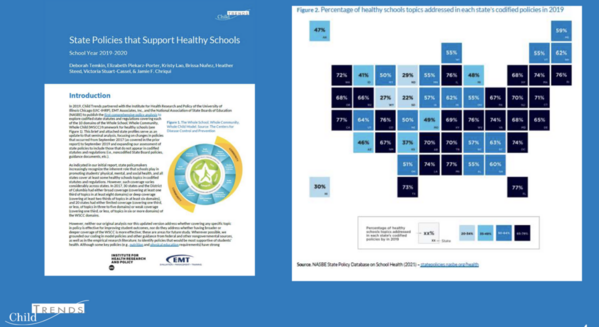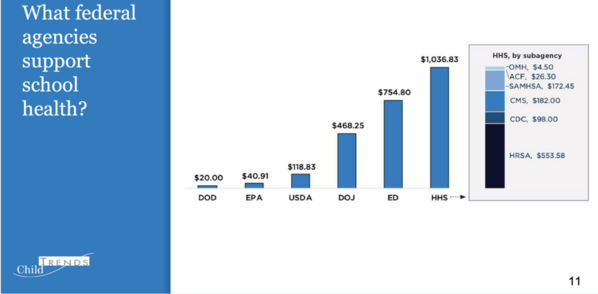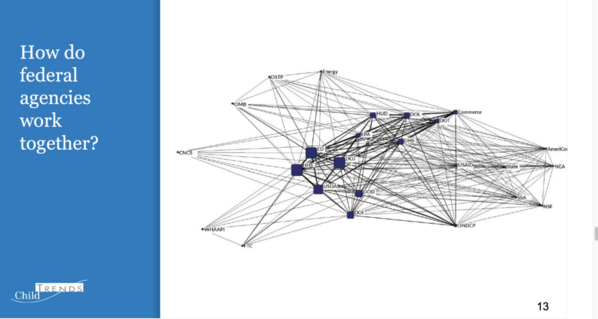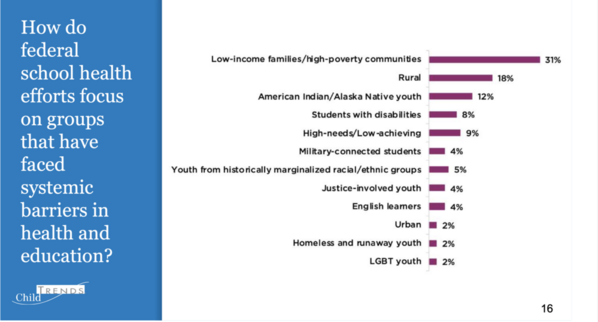After educators’ experience with the COVID-19 pandemic, a 2014 approach to school health has gained even greater urgency. Under this model, a student's physical health is considered to be inseparable from their mental and social health. Moreover, it assumes that school climate, family engagement, community involvement, and, importantly, the health of school staff are all integral to the health of students.
Researchers with ChildTrends recently released a report using metrics based on this broad model of health, known as the Whole School, Whole Community, Whole Child framework (WSCC). The framework was developed by the Centers for Disease Control and Prevention and includes:
- Health education
- Access to healthy food
- A workplace that fosters physical and mental well-being of school staff
- An environment that promotes the social and emotional development of students
- A school building that is environmentally safe and free from physical hazards
- Access to mental health services at school or with community partners
- Partnerships with community groups that support students’ learning and health-related activities
- Family engagement
- Physical education
“When we talk about school health, we don't just mean health services or health education and physical education. We truly mean all of the supports, from social emotional learning to school discipline policies to air quality, that form the conditions for learning,” said the report’s lead author, Deborah Temkin.
On Aug. 30, Kaiser’s Institute for Health Policy hosted a webinar entitled “The Future of Healthy Schools: Supportive Funding, Systems Change, and Community Collaboration.” The springboard for discussion was a new analysis by ChildTrends detailing precisely how federal funding for physical and mental health in schools is siloed, piecemeal and inequitable, and then offering potential solutions. Speakers included Temkin, the vice president for Youth Development and Education Research at ChildTrends; Charlene Russell-Tucker, the acting commissioner of education for the Connecticut State Department of Education; and Holly Hunt, chief of the Healthy Schools Branch in the Division of Population Health at the CDC’s National Center for Chronic Disease Prevention and Health Promotion.
The speakers talked about what gives them hope and what it takes to develop sustainable collaborations across agencies that withstand changes in leadership.
Good news, bad news
The ChildTrends report analyzed state statutes and regulation as well as policies across 200 topics related to school health. “The good news is that every state has at least some policies that target school health in some way,” said Temkin.
However, she said, there is little coordination, and many states go only part way in addressing all the areas that would make a school a safe space that meets the emotional, mental and social needs of students and staff. The measure of how far schools are moving the needle forward on all 10 WSCC metrics ranges from 22% to 80%. (To view the entire slide deck up close, click here.)
Temkin said ChildTrends’ research was based on three questions:
- What federal agencies support school health initiatives and how do they work together?
- How do federal school health efforts advance the emotional, mental and social needs of an entire school?
- How do federal school efforts focus on groups that have faced system barriers in health and education?
The major federal funders of discretionary grants for school health are the Department of Education, the Department of Health and Human Services, and the Department of Justice. Other agencies, including the Department of Agriculture, the Environmental Protection Agency and the Federal Communications Commission, also fund elements of school health.
Total amounts of discretionary funding for school health are misleading, Temkin said, because school health-related grants are lumped together with other grant programs. For example, in 2019-2020, school health encompassed social emotional learning as well as professional development for teachers. “The amount of funding that actually was dedicated to school health is likely much smaller than the numbers suggest,“ she said.
Temkin and her co-authors also saw how funding from the federal government shifted in response to particular events, such as the 2018 school shooting that killed 17 students and staff in Parkland, Florida.
“An interesting switch occurs,” Temkin said. School health funding through the Department of Justice had increased signficantly, but closer inspection revealed that “These funds largely relate to school safety, and specifically school hardening (a term that refers to security measures), both in the form of infrastructure and hiring school resource officers,” she said. “It's particularly notable given the relative amount compared to other, more broadly preventative school health efforts.”
Built-in bias
The report also analyzed funding for school health programs that required cross-agency collaboration. It showed that specialized health programs, including those geared specifically to benefit the overall health of people of color, have been siloed and left out in the wilderness. That is they’re not part of networks that are included in interagency work groups.
Those programs include Department of the Interior efforts to help American Indian and Alaska Native children and White House initiatives on educational excellence for Hispanic and Black students, she explained.
Researchers also found clear bias in language used to describe some grant programs that target minorities.
For example, she said, the term “high minority schools” often implied that the schools were naturally low-achieving. “This is very problematic,” she said. “Most grant programs use a deficit lens and targeting, implying that communities themselves are at risk, rather than specifically calling out the systemic and historic inequities that have led to the disparities that we see.”
The ChildTrends report also noted that:
- Few federal school health efforts include a focus on employee wellness.
- There are limited federal school health programs designed for students who face systemic barriers to health and education.
It comes down to trust
Reflecting on the report and lessons learned from the pandemic, the CDC’s Holly Hunt said that they have forced the agency to work much more closely with other agencies, such as the Substance Abuse and Mental Health Services Administration. “I think having this report actually gives us one step ahead, because now we know where some strains are, where some opportunities are that we didn't necessarily know before,” she said.
For Charlene Russell-Tucker, the way forward means understanding how necessary supports for physical health, mental health and related social factors are tied up with learning. “There's no curriculum brilliant enough to compensate for a hungry stomach or distracted mind,” she said.
She noted that her goal as the commissioner of education in Connecticut is to get providers for physical and mental health embedded in all of the state’s 1,500 schools. “So now we have to step back and ask how we organize ourselves for this level of coordination that is so fundamental and so necessary.”
To be able to develop collaborations that endure, said Hunt, “It’s all about building relationships.” Russell-Tucker agreed, adding one word to the mix. “Trust.”
“We’re talking about trusting relationships that can survive,” she said. “Whatever your organization is, it has to be able to survive beyond that charismatic leader. You develop a coalition and make sure that you embed those changes within the organizational structure and fabric, and relationships and trust will help (the coalition) survive.”









Comments (0)